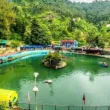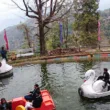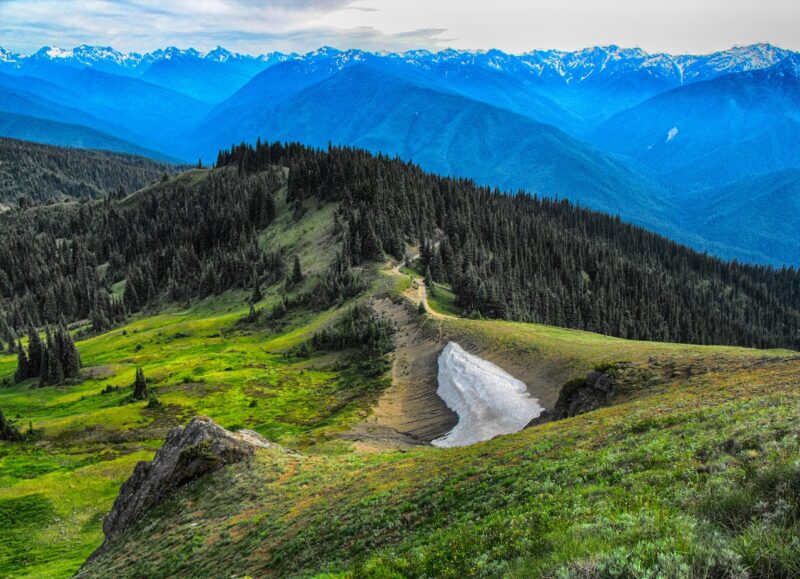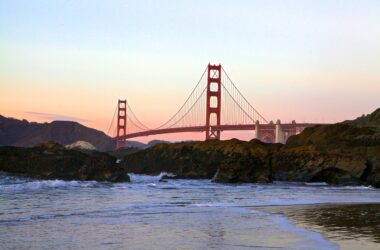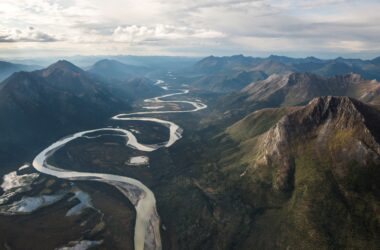Glacier Bay National Park, located in southeastern Alaska, is one of the most pristine and beautiful wilderness areas in the world. Encompassing over 3 million acres of rugged mountains, fjords, glaciers, and temperate rainforests, this remote park is a paradise for outdoor enthusiasts and nature lovers alike.
Named for the massive glaciers that have carved the landscape over thousands of years, Glacier Bay is a place of stunning natural beauty, where visitors can experience the raw power and majesty of nature in its purest form. From towering glaciers that calve into the sea, to ancient forests teeming with wildlife, this park offers a wealth of opportunities for adventure and exploration.
Whether you’re an experienced hiker, a seasoned kayaker, or simply looking for a peaceful retreat in the midst of nature, Glacier Bay Park has something for everyone. In this article, we’ll take a closer look at this magnificent park, exploring its history, ecology, and some of the most popular activities and attractions it has to offer.
History of Glacier Bay National Park
The story of Glacier Bay National Park begins over 200 years ago when it was first discovered by European explorers. In 1794, Captain George Vancouver sailed into the bay, naming it after the massive glaciers that filled the area. Over the next century, the area was visited by a number of explorers and adventurers, who were awed by the beauty and majesty of the glaciers.
In the late 1800s, the area around Glacier Bay began to attract more visitors, who were drawn by the stunning scenery and abundant wildlife. In 1916, President Woodrow Wilson established the park as a national monument, in order to protect its natural beauty and preserve it for future generations.
Over the years, the park has undergone a number of changes and expansions. In 1980, it was designated a national park and preserve, and its boundaries were expanded to include over 3 million acres of land and water. Today, Glacier Bay National Park is a popular destination for tourists from around the world, who come to experience the beauty and wonder of this unique wilderness area.
Ecology of Glacier Bay National Park
Glacier Bay National Park is home to a wide variety of ecosystems and habitats, each of which plays a vital role in the overall health and balance of the park’s ecology. From the icy waters of the bay to the lush rainforests that line its shores, Glacier Bay is a place of incredible biological diversity.
One of the most distinctive features of Glacier Bay is its glaciers. These massive ice formations are the result of thousands of years of accumulation and compression, and they play a crucial role in the park’s ecology. As the glaciers move and calve, they create new habitats for a variety of plant and animal species, including harbor seals, sea otters, and a variety of sea birds.
In addition to its glaciers, Glacier Bay is also home to a number of temperate rainforests, which are among the most biologically diverse ecosystems on Earth. These forests are dominated by towering trees such as Sitka spruce, western hemlock, and Alaska cedar, and are home to a wide variety of wildlife, including black bears, wolves, and mountain goats.
The waters of Glacier Bay are also rich in marine life, including whales, porpoises, and sea lions. The park is also home to a variety of fish species, including salmon, halibut, and lingcod, which support a thriving commercial fishing industry.
Activities in Glacier Bay National Park
With so much natural beauty and diversity, Glacier Bay National Park offers a wide variety of activities and attractions for visitors to enjoy. Whether you’re looking for a thrilling adventure or a peaceful retreat in the wilderness, there’s something for everyone in this incredible park.
- Glacier Viewing: One of the most popular activities in Glacier Bay is viewing the massive glaciers that dominate the landscape. Visitors can take a guided boat tour or kayak trip to get up close and personal with these incredible ice formations, watching as they calve into the sea with a thunderous roar.
- Wildlife Watching: Glacier Bay is home to a wide variety of wildlife, including brown bears, black bears, mountain goats, moose, and a variety of bird species. Visitors can take guided tours to explore the park’s wilderness areas and catch a glimpse of these incredible animals in their natural habitats.
- Hiking: With over 700 miles of trails to explore, Glacier Bay is a hiker’s paradise. From easy nature walks to challenging backcountry treks, there’s a trail for every level of experience and fitness. Along the way, hikers can take in stunning views of the park’s glaciers, forests, and wildlife.
- Kayaking: For a more up-close and personal experience of Glacier Bay, visitors can take a guided kayak tour through the park’s fjords and waterways. Paddling along the coast, visitors can explore hidden coves, watch for wildlife, and soak in the stunning natural beauty of the park.
- Fishing: The waters of Glacier Bay are home to a variety of fish species, including salmon, halibut, and lingcod. Visitors can take guided fishing trips to catch their own dinner, or simply enjoy the peaceful solitude of casting a line in the park’s pristine waters.
- Camping: For a truly immersive wilderness experience, visitors can camp in one of the park’s many backcountry campsites. With options ranging from car camping to remote wilderness camping, Glacier Bay offers a unique opportunity to disconnect from the world and connect with nature.
- Ranger-led Programs: To learn more about the park’s history and ecology, visitors can participate in ranger-led programs, which offer guided tours, hikes, and educational talks about the park’s natural wonders.
Conclusion
Glacier Bay National Park is a place of awe-inspiring natural beauty, where visitors can experience the power and majesty of nature in its purest form. From its massive glaciers and towering mountains to its lush forests and abundant wildlife, this remote wilderness area is a treasure trove of adventure and exploration.
Whether you’re an experienced outdoor enthusiast or simply looking for a peaceful retreat in the midst of nature, Glacier Bay has something for everyone. With its incredible diversity of ecosystems and habitats and a wide variety of activities and attractions to explore, this park is truly a must-see destination for anyone seeking to connect with the natural world.
Similar Articles
- The Last Frontier: An Epic Summer Vacation in Alaska
- 15 Best Restaurants in Anchorage
- Discover the Beauty of Alaska on the Norwegian Pearl
Frequently Asked Questions About Glacier Bay National Park
If you’re planning a trip to Glacier Bay National Park, you may have some questions about what to expect and how to make the most of your visit. Here are some frequently asked questions about Glacier Bay National Park:
- What is Glacier Bay National Park?
Glacier Bay National Park is a remote wilderness area located in southeastern Alaska. The park covers over 3 million acres of land and water and is home to a variety of natural wonders, including glaciers, mountains, fjords, and wildlife.
- How do I get to Glacier Bay National Park?
The park is only accessible by boat or plane. The closest major city is Juneau, Alaska, which has a small airport and is serviced by several major airlines. From Juneau, visitors can take a commercial flight or a ferry to the park.
- What is the best time of year to visit Glacier Bay National Park?
The best time to visit Glacier Bay National Park is during the summer months, from June to August. During this time, the weather is typically mild and sunny, and the park’s wildlife is most active. However, be prepared for rain and cooler temperatures, as the weather in Alaska can be unpredictable.
- What should I pack for a trip to Glacier Bay National Park?
Be sure to pack warm, waterproof clothing, sturdy hiking boots, and plenty of layers, as the weather in the park can be unpredictable. It’s also a good idea to bring sunscreen, bug spray, and a camera to capture the park’s natural beauty.
- What activities are available in Glacier Bay National Park?
Visitors to the park can enjoy a variety of activities, including glacier viewing, wildlife watching, hiking, kayaking, fishing, and camping. There are also ranger-led programs and guided tours available for those who want to learn more about the park’s history and ecology.
- Can I camp in Glacier Bay National Park?
Yes, there are several campgrounds and backcountry campsites available in the park. Reservations are recommended, especially during peak season.
- Is it safe to visit Glacier Bay National Park?
While the park is generally considered safe, visitors should be aware of the potential dangers of wildlife encounters, cold water temperatures, and unpredictable weather. It’s important to follow park rules and regulations and to always be prepared for emergencies.
- What should I do if I encounter a bear in Glacier Bay National Park?
If you encounter a bear in the park, it’s important to remain calm and give the bear plenty of space. Do not approach the bear or try to feed it. If the bear begins to approach you, stand your ground and make loud noises to scare it away.
- Are there guided tours available in Glacier Bay National Park?
Yes, there are several companies that offer guided tours of the park, including boat tours, kayak tours, and hiking tours. These tours can be a great way to learn more about the park’s natural wonders and to experience the wilderness in a safe and informative way.
- Can I bring my own boat or kayak to Glacier Bay National Park?
Yes, visitors are allowed to bring their own boats and kayaks to the park. However, there are specific regulations and guidelines that must be followed, including obtaining a permit and following park rules and regulations. It’s important to check with park officials before bringing your own watercraft into the park.


